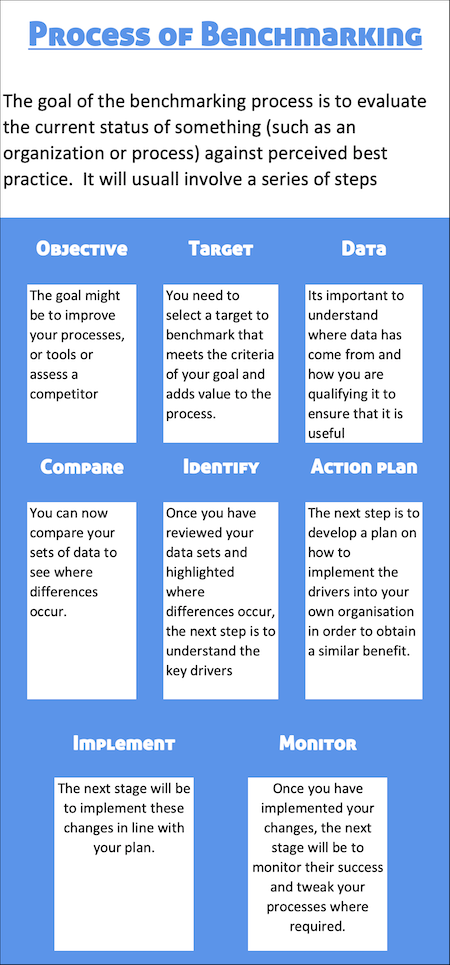
The process of benchmarking typically involves a series of steps which include:
- Setting an objective
- Identify Who/What you will benchmark against
- Gathering data
- Comparing data
- Identify drivers behind differences
- Establish an action plan to imbed beneficial changes
- Implement
- Monitor and repeat
The goal of the benchmarking process is to evaluate the current status of something (such as an organization or process) against perceived best practice.
In today’s article, we’ll be reviewing the process of benchmarking we’ll be covering:
- What is the process of benchmarking
- What are the types of benchmarking
- What is the most effective use of benchmarking in the change process?
- Who is responsible for the benchmarking process
- When is the process of benchmarking used?
- Issues with process of benchmarking
- Benefits of the process of benchmarking
What is the process of benchmarking
As we described during the introduction, the process of benchmarking can be broken down into a series of steps – these include:
1/ Setting an objective
There is no point in benchmarking unless you have a goal. This goal might be that you’re looking to improve your processes, or you might be doing some competitor analysis within your industry, or you might simply be trying to assess whether it might be worthwhile implementing different tools within your business.
Whatever your goal or objective is, having one will help ensure that the rest of your benchmarking process is established to help you achieve what you’re setting out to do.
2/ Identifying your benchmark target (who you will benchmark against). Once again, this is another crucial step that many organisations get wrong. Benchmarking against anyone will not suffice; it needs to be the right someone. You need to select a target to benchmark that meets the criteria of your goal and ultimately will provide value to the process.
What does this mean? Well, let’s take a look at an example:
Perhaps you’re an aerospace company that’s looking to implement best practice into their assembly line. Choosing an appropriate benchmarking target is essential; it would be pointless, for example, using a fast-food outlet to benchmark against; it’s a different industry with different regulatory requirements and vastly different complexity levels.

3/ Gathering data
The next stage in the process is to gather data both from your own organisation and from that of who you are benchmarking against.
As ever data can be very misleading, it’s important to understand where data has come from and how you are qualifying it to ensure that it is meaningful and suitable.
The dangers of selecting inappropriate data can be significant and can produce results that could be misleading. This can cause wasted effort and failure to achieve your target.
Many organisations do not invest sufficient time in this task. Have a plan ready before you start and be clear on key aspects such as
- The time period being assessed
- The volume being assessed
- What data points are being captured
- How do you qualify the information captured?
- Whether the data is representative of normal business
4/ Comparing data
Assuming that you have captured your data correctly, you will now be in a position where you can compare two sets of data (yours and that of what your benchmarking) to see where differences occur.
There are various ways that you can compare data during the benchmarking process; these include
- Spread of results
- Standard deviation
- Quantity of occurrences over time
- Unusual issues/occurrences
- The shape of results (i.e. symmetry or skewed results)
5/ Identify drivers behind differences
Once you have reviewed your data sets and highlighted where differences occur, the next step is to understand the key drivers behind the differences.
This is a crucial step requiring focus and quantitive and qualitative assessment. This generally requires further detail (or interpretation by a subject matter expert).
Getting this stage wrong might lead you to implement changes that may not drive the benefits that you are expecting.
Drivers can be varied, and of significant volume, so you may need to apply further tools such (e.g. Pareto analysis) to help understand the key themes.
6/ Establish an action plan
Once you have identified the key reasons behind the differences in the two data sets, the next step is to develop a plan on how to implement the drivers into your own organisation in order to obtain a similar benefit.
In many cases, it may require investment which may often require approval within the business.
7/ Implementation
The next stage will be to implement these changes in line with your plan.
8/ Monitor and repeat
Once you have implemented your changes, the next stage will be to monitor their success and tweak your processes where required.
Benchmarking is not a one-off activity but one that exists in cycles; as a result benchmarking is a process that requires continuous focus in order to get the best benefits.
What are the types of benchmarking
There are a number of types of benchmarking these include
- Performance – This involves assessing and comparing quantitive data from the internal organisation against the benchmarking target. This often involves reviewing metrics or KPIs against Standard industry data or competition data where available.
- Process – this involves assessing activities and how they are executed. This may involve comparing process maps from one organisation to another, providing insight into performance and best practice gaps.
- Internal – Internal benchmarking is where an organisation reviews its own processes internally. This requires at least two areas that could be compared against each other in similar ways, (i.e. they do the same thing). This activity can help large organisations understand where different elements of their business are more effective than others.
- External – external benchmarking compares practices and quantitive data such as metrics from one organisation to that of another.
What is the most effective use of benchmarking in the change process?
The key use of benchmarking within the change management process is to drive change itself. Through highlighting best practices that can be implemented within the organisation, benchmarking can support management in providing justification for change. This can help transition the organisations from one method of working to another.
The benchmarking process can help significantly reduce the change cycle.
Many organisations change incrementally, often using an improvement process where small changes are identified and then implemented. Through the benchmarking process, large gaps can be identified, which can then be implemented, securing more significant improvement than a typical incremental change management process would.
Who is responsible for the benchmarking process
The benchmarking process is normally instigated by somebody within a leadership position who is looking to introduce best practice to the organisation.
In its execution, The benchmarking process requires a variety of skills, from quantitive data analysis through to process mapping and, in some cases, in-depth knowledge about the particular industry involved.
As a result, the benchmarking activity may be conducted by a small, suitably qualified team who typically work within the quality management function.
It’s not unusual for this team to be supported by different aspects of the business we are shut subject matter experts are required.
For example, where you are assessing a procurement process, you may include a member of the supply chain team in the analysis.
When is the process of benchmarking used?
The benchmarking process should be seen as a continuous improvement tool, i.e. used all of the time.
There may also be specific periods where you may want to use it to provide specific benefits. These may include,
- Cost reduction programs
- Competitive assessment
- Change
- Improvement programs
- When implementing new products or processes
- Mitigating poor performance
Issues with Benchmarking process
There can be a variety of issues with the benchmarking process; these include,
- Selecting appropriate benchmark targets
- Capturing data that does not drive a decision
- Poor understanding of key drivers for differences
- Implementing the wrong changes believing that they will deliver success
- Failure to get leadership engagement
- Expecting it to be a panacea for solving problems
Benefits of Benchmarking process
There are numerous benefits from the benchmarking process, A summary of these include
- A simple, repeatable way of capturing ideas for continuous improvement
- An effective way of establishing performance against external candidates
- A way of engaging the workforce in change
- Way of capturing key drivers within the industry
- A way of facilitating change within the company
Summary
The benchmarking process is a common activity utilised by many businesses in order to drive improvement.
The process contains a number of steps, from planning the benchmarking through to implementing changes required for benefit.
Benchmarking can occur in all industries and all types of companies.
It offers a simple route to obtaining benefits.
Have you utilised the benchmarking process in your organisation? Perhaps you have some tips or tricks you’d be able to share with our readers.
As ever, we love your comments. You can reach us on Twitter via the comment section below.
